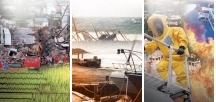|

Critical Infrastructure Protection
The Government of Canada is committed to ensuring the ongoing health,
safety, security and economic well being of Canadians. Through the Office
of Critical Infrastructure Protection and Emergency Preparedness (OCIPEP)
the Government of Canada is enhancing Canada's ability to protect its
critical infrastructure, which includes:
- Energy and utilities (gas, oil and electricity);
- Transportation (air, water, rail or land);
- Communications (telephone, Internet, satellite, radio, TV);
- Safety (police, fire, ambulance, nuclear safety, 911 services, search
and rescue);
- Financial, food and health services (banking, agriculture and food
distribution, water treatment, hospitals, pharmaceuticals); and
- Government services (pensions, employment insurance, immigration,
weather forecasting, education, other social benefits, etc).
 Severe
weather, greater urbanization and aging infrastructure have increased
the degree to which our critical infrastructure is affected by emergencies
of any nature - natural or human-induced. Our critical infrastructure
is so heavily reliant upon information technology that a single disruption
or failure in any one of these sectors could cause cascading effects that
would potentially impact millions of Canadians. Severe
weather, greater urbanization and aging infrastructure have increased
the degree to which our critical infrastructure is affected by emergencies
of any nature - natural or human-induced. Our critical infrastructure
is so heavily reliant upon information technology that a single disruption
or failure in any one of these sectors could cause cascading effects that
would potentially impact millions of Canadians.
OCIPEP currently monitors and verifies the information gathered from
multiple sources (inside and outside government) and actively disseminates
alerts, advisories, and other information products to Government of Canada
departments and agencies, provincial and territorial governments, critical
infrastructure owners and operators, academia, and the general public.
The benefits of the OCIPEP on-line service delivery are:
- an enhanced national capacity to respond to threats, and reduced vulnerabilities;
- reduced potential impacts of cyber attacks through co-ordination of
protective measures;
- a broadened national access to cyber threat and vulnerability information,
including remedies for these;
- an increased level of preparedness and Canadians' sense of security
by sharing operational and practical emergency preparedness information;
- helping ensure continuity of government operations and government
services in the event of malicious attack or natural disaster; and
- the establishment of a more cohesive and effective system of critical
infrastructure protection in Canada.
 OCIPEP
is implementing web-enabled solutions that will foster and facilitate
collection and distribution of information among key infrastructure sectors
and affected stakeholder groups. This will help reduce potential impacts
of cyber attacks by co-ordinating protective measures across and among
government departments and critical infrastructure owners and operators
- private and public - nationally and internationally. OCIPEP communication
material provides Canadians with information regarding these plans, where
appropriate and consistent with security requirements necessary for the
protection of this information. OCIPEP
is implementing web-enabled solutions that will foster and facilitate
collection and distribution of information among key infrastructure sectors
and affected stakeholder groups. This will help reduce potential impacts
of cyber attacks by co-ordinating protective measures across and among
government departments and critical infrastructure owners and operators
- private and public - nationally and internationally. OCIPEP communication
material provides Canadians with information regarding these plans, where
appropriate and consistent with security requirements necessary for the
protection of this information.
More information about the OCIPEP and its linkage to the Public Safety
gateway is available at: http://www.ocipep-bpiepc.gc.ca/
The OCIPEP Canadian Disaster Database contains historical information
on disasters, which have directly affected Canadians, both at home and
abroad, over the past century. For further information check the following
site: http://www.ocipep.gc.ca/disaster/default.asp
|
